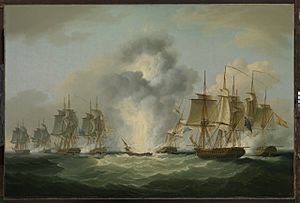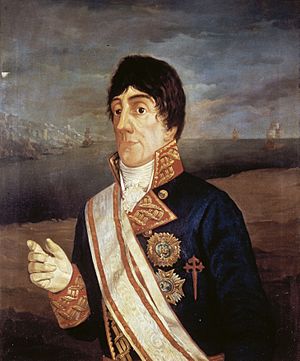José de Bustamante y Guerra facts for kids
José de Bustamante y Guerra (born April 1, 1759, in Corvera de Toranzo, Cantabria, Spain – died March 10, 1825, in Madrid, Spain) was an important Spanish naval officer, explorer, and politician. He is often simply called Bustamante.
Contents
José de Bustamante y Guerra came from a family with a long history in Spain. When he was just 11 years old, in 1770, he joined the Academy of the Guardiamarinas in Cádiz. This was a special school for young people who wanted to become naval officers. By June 1771, he was already a second lieutenant.
He sailed in many naval missions in the Mediterranean Sea, fighting against pirates. On one trip to the Philippines, his ship, the Santa Inés, was captured by a British warship. Luckily, Bustamante was soon set free and returned to Spain.
In 1782, he bravely fought in a naval battle near Gibraltar, even though he was wounded. His ship was badly damaged. After this, he helped plan a mission to take over Jamaica, but this plan was stopped when peace was made in 1783. By 1784, he was a captain and was recognized as a knight of the Order of Santiago.
Around this time, he started planning a big scientific journey with his friend, Alessandro Malaspina.
The Malaspina-Bustamante Expedition
In 1788, Bustamante and Malaspina suggested to the Spanish government a huge scientific expedition. They wanted it to be like the famous voyages of James Cook. The government liked the idea, and two special ships were built for the journey.
Bustamante commanded the ship named Atrevida, which means "daring" or "bold". Malaspina commanded the Descubierta, meaning "discovered". They chose these names to honor James Cook's ships, the Discovery and Resolution. Both Malaspina and Bustamante were in charge of the expedition together.
This journey lasted from July 30, 1789, to September 21, 1794. It was first called "Scientific and Political Travel around the World". Today, it is best known as the Malaspina Expedition or the Malaspina-Bustamante Expedition. The team included the best naval officers, along with botanists, painters, doctors, and other smart people.
From 1789 to 1794, Bustamante and Malaspina sailed across the Atlantic and Pacific Oceans. They visited almost all the Spanish colonies and explored many unknown areas. Their journey took them to places like:
- Spanish America (including Buenos Aires, Montevideo, Patagonia, Malvinas/Falkland Islands, Chiloé island, Talcahuano, Valparaíso, Santiago de Chile, El Callao, Guayaquil, Nueva Granada, Acapulco, California).
- The Pacific Northwest (Alaska), looking for a connection between the Pacific and Atlantic Oceans.
- Spanish Asia (Philippines, Marshall and Mariana Islands).
- Macao (on the coast of China), New Guinea, Celebes, Moluccas, and Tonga Islands.
- New Zealand and Australia.
Sometimes, the two ships would separate to do different tasks. For example, Bustamante would stay close to the coast to map it, while Malaspina explored islands further out. Bustamante even sailed very far south, reaching 57 degrees south latitude, which is close to the South Pole.
When the expedition returned to Spain in 1794, Bustamante was promoted to captain and then to navy brigadier. He also kept a detailed diary during the expedition, which was published later in 1868.
Later Life and Public Service

After the expedition, Bustamante continued to work with Malaspina for a short time. However, Malaspina was later put in prison for political reasons. Bustamante managed to stay out of these troubles.
In 1796, he was chosen to be the political and military governor of Paraguay and the Commander-General of Río de la Plata (which included being the Governor of Montevideo).
On October 5, 1804, while it was peacetime, Bustamante was sailing back to Spain with four Spanish ships. They were suddenly attacked and captured by a British group of ships. This happened without any warning or declaration of war between Britain and Spain. Bustamante was eventually released. This event was a big reason why Spain officially declared war on Great Britain on December 14, 1804, and joined forces with France during the Napoleonic Wars.
In 1810, he became the Captain General of Guatemala. He stayed in this important role until 1817. During this time, there was a lot of activity for independence in the region. Bustamante tried to make reforms, but he also had to deal with rebellions. He prepared troops in Guatemala and created a special group called the "Fernando VII volunteer corps" to fight against the rebels.
José de Bustamante y Guerra passed away in 1825 when he was 66 years old. In his will, he gave a lot of money to support children's schools in Ontaneda, which his brother Francisco had started.
See also
 In Spanish: José de Bustamante y Guerra para niños
In Spanish: José de Bustamante y Guerra para niños



